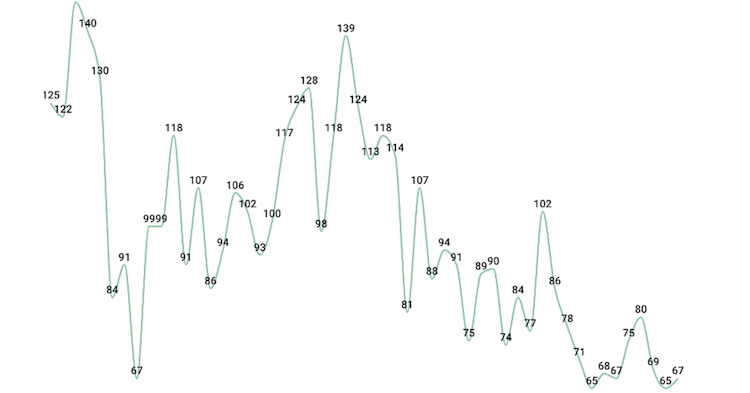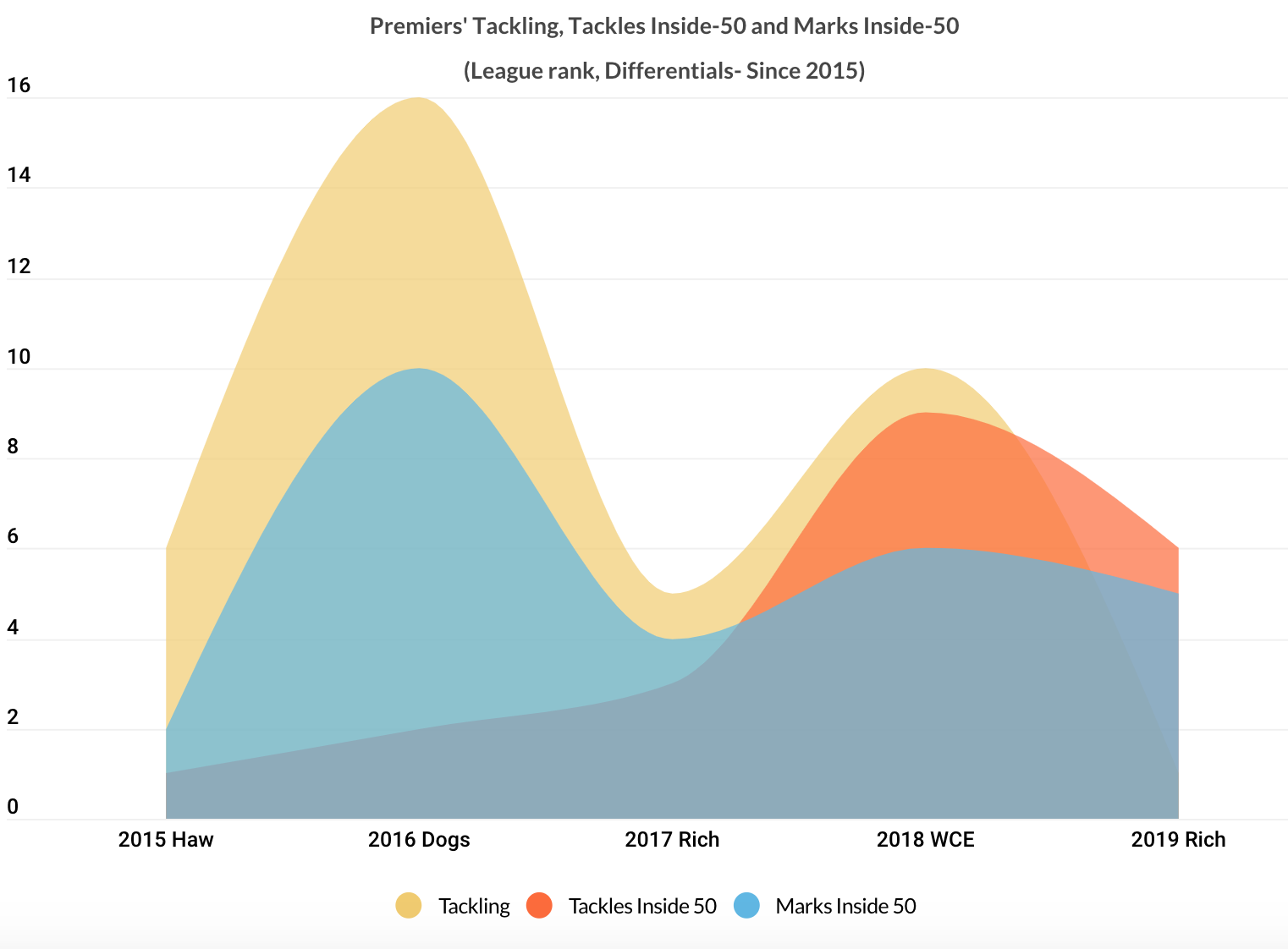AFL | Stats That Matter - The Changing Face of the Forward
Last updated: Apr 15, 2020, 5:20AM | Published: Apr 15, 2020, 1:13AM
If you love the AFL and are older than say, thirty, it’s likely your formative football appreciating years were dominated by a very different kind of forward.
From a physical level through to the very function of the modern forward, no position has undergone a more dramatic facelift, with our sport transitioning into a much more strategically complex equation.
While once upon a time the goalscoring leviathan constituted one the game’s biggest attractions and community inspirations, it's a feature that truly appears to have vanished with little chance of it ever coming back.
For many, the changing role of the modern forward has been both confronting and difficult to reconcile with.
Today, we’ll investigate how the change took place, what the modern forward looks like, and what role they might play into the future.
WANT MORE AFL CONTENT? Join the free mailing list to get the best content delivered straight to your inbox.
WHERE HAVE WE BEEN?
Until the new millennium we were living in a world where with 100+ goal tallies were the norm, and where the full forward was the team’s megastar.
Between 1968 and 2001, 29 of the 34 Coleman medals were won with returns of at least 90 goals, with 18 being punctuated with a century of majors.
However, just one of the last 18 Colemans have been won with a player breaching 90 goals (Lance Franklin in 2008) while the disappearance of century goal scorers has been even more pronounced.

In the history of the VFL/AFL, a 100-goal season has been achieved 57 times, however it’s a feat that’s been accomplished on just three occasions since 1998, and not once since Franklin’s phenomenal 2008 campaign.
The game’s biggest proponents of the heavy duty goalscorer speak of a simpler time, and in many respects the role of the full forward satisfied that reality.
Indeed the team’s best mark, perhaps its strongest physically as well, would patrol the goal square, with the lion share of a team’s attack running through him.
The full forward was tasked with leading out, out-manoeuvring his opponent and ideally finishing off the hard work of his midfield with pin-point accuracy. Little was expected nor asked of him on the defensive end.
And this situation thrived right through to the nineties too. As profoundly brilliant as Coleman medalists and living legends Tony Lockett, Gary Ablett Snr and Jason Dunstall were, precious little was expected of them from a defensive perspective, with their domain largely confined to within thirty metres of goal.
 So what prompted the shift? Where did all the big-time goal scorers go and will they ever come back?
So what prompted the shift? Where did all the big-time goal scorers go and will they ever come back?
While the likes of Matthew Lloyd, Fraser Gehrig and Brendan Fevola kept the flame burning throughout the nineties, the tactical revolution that engulfed the sport over the last 15 years unquestionably transformed the traditional role of the key forward.
The new world demanded that key forwards be multi-faceted, be more aerobically capable and most importantly, be able to contribute on the defensive end as well.
ALSO READ: The Tactical Evolution of AFL
Curiously, it was a simultaneous revolution among small forwards which helped expedite this transformation, as smaller, nippier players demonically tackled their way to prominence, while also solidifying their importance to the team by keeping the scoreboard ticking themselves.
While the likes of Josh Kennedy, Lance Franklin, Jack Riewoldt and Jarryd Roughead were all phenomenal goal scorers and Coleman medalists in their own right, they were starkly different from their predecessors both in physique and through their positional adaptability. They pushed higher up the ground, made their presence felt far from goal and contributed strongly from a tackling perspective too.
In many respects, these very players changed the sport forever.
WHERE ARE WE NOW?
The modern forward is very much a product of the tactical advancements of the last 15-20 years.
If we look at the shape and composition of recent premiers, there’s a strong correlation not only with teams who tackle maniacally, but whose forwards play a crucial role from a defensive perspective too.
Most importantly, the modern key forward remains integral, however the best clubs have been able to re-imagine roles for such players.

With the exception of the Western Bulldogs’ 2016 triumph, every modern premier has had at least one ‘traditional’ key forward, more associated with size, large goal tallies and a pronounced physical presence inside 50.
The difference however among such forwards is that they’ve been able to expand their role to go beyond the usual job description.
Like so many facets of the modern game, the Richmond Football Club are also at the forefront of challenging the traditional assumptions of the forward line. While the 2019 addition of Tom Lynch provided the appearance of a more standard set up, he and Jack Riewoldt are deceptively mobile for their sizes as well as being incredibly aggressive tacklers inside 50.
It’s the Tiger’s small forwards however who’ve inspired so much terror in the heart’s of opposing defenders, with the likes of Daniel Rioli, Jason Castagna, Shai Bolton etc being critical to the way the Tiger’s like to play.
At this point in the AFL’s tactical revolution, we seem to have arrived at a point where key forwards remain fundamental, but where an incredible defensive presence forward of centre is just as pivotal.
WHERE ARE WE GOING?
While sure, the days of massive Coleman medal tallies appear over, clubs will continue to strive to unearth elite key forward talent. The overarching aspect however is that the best clubs will be increasingly selective about how they procure and deploy such talent.
Recent trends at the AFL Draft back this up.

We’re increasingly seeing less of a run on bigger players among premium selections, with most clubs preferring to go with safer midfield bets, speculating on players more likely to be able to contribute right away.
While the likes of St Kilda and Gold Coast haven’t been able to resist the siren song of the key forward with selections such as Max King and Jack Lukosius in recent years, the trend appears to speak to a more patient approach regarding key forwards.
The draft has provided a further window on which positions are being prioritised in the modern game, particularly among forwards.
Traditionally, clubs have balked at taking small forwards in the first round of the draft, however Cyril Rioli profoundly altered the list management landscape when the Hawks took him with selection 12 in 2007, with his immediate and considerable impact changing clubs' approach to list management.
In last November’s draft, the Demons were prepared to take Kysaiah Pickett with selection 12, indicating more of a willingness to look outside the box, placing an increased importance on players not traditionally thought of as first round investments.
Richmond’s Daniel Rioli was evidence of this changing trend in 2015, along with other recent examples such as Jaidyn Stephenson and Liam Ryan in 2017- two players who would square off in a Grand Final less than 12 months later.
At the trade table and in free agency too, we’ve seen a very different approach to small forwards with clubs prepared to give up significant resources (and big contracts) to procure elite, non key-forward talent. The likes of Chad Wingard, Luke Dahlhaus and Charlie Cameron didn’t come cheap for their respective clubs, while last October’s intense pursuit of Tom Papley was indicative of the market’s shift.
CONCLUSION
So long as forwards keep kicking goals they will remain relevant, while the big marking key forward still has a role to play in the contemporary AFL.
While we got comfortable marvelling at the goal kicking feats of the incredible full forwards of yesteryear, it was easy to not notice the revolution taking place, literally at their feet, as the smaller forward gained increasing prominence and forced traditional key forwards to modify their game.
The revolution not only changed the very way we watch matches, but it's completely altered the way clubs structure their lists, and where they allocate salary cap resources.
The very best clubs have been ahead of the changes, and in many cases, claimed premierships. Those that haven't have remained mired outside flag contention, scratching their heads as to why they keep getting it so wrong.
Did you enjoy this article? Join our free mailing list to get the best content delivered straight to your inbox, or join the conversation by leaving a comment below or on the Stats Insider Twitter or Facebook page.



